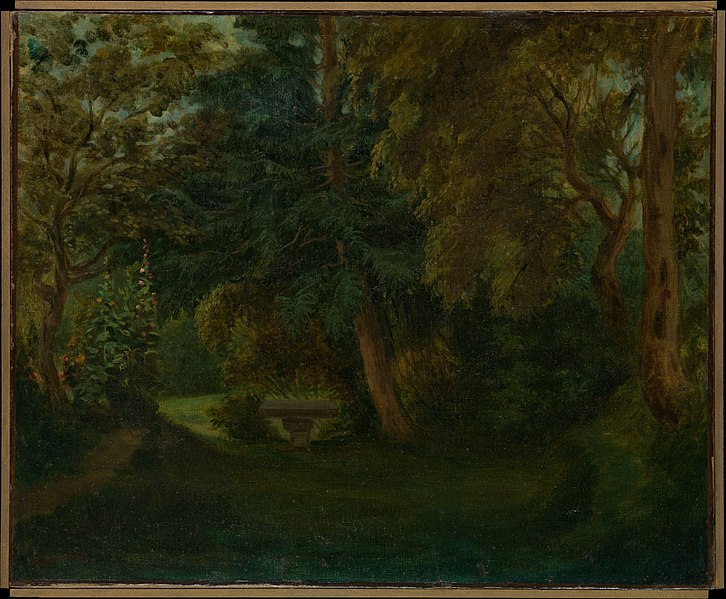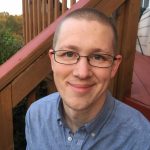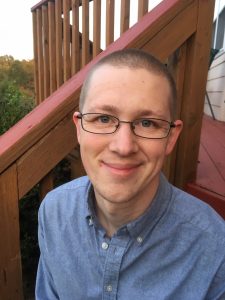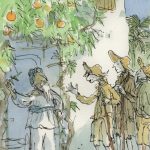Even unto them will I give in mine house and within my walls a place and a name better than of sons and of daughters: I will give them an everlasting name, that shall not be cut off. Is. 56:5
An excerpt from Leaves of Healing: A Year in the Garden, out today from Belle Point Press.
Reeds Spring, Missouri. We live on the fringes of what I have heard called “Vacationland,” sixteen miles from Branson, Missouri, and just off one of this region’s chain of manmade recreational lakes. And summer is the season. We don’t do much in the tourist areas, being stereotypical crotchety locals, but we notice the busier roads, the fuller checkout lines, and the general froth of activity all around our home.
We could extract ourselves from this whirl if we chose, go off and take our own vacation. My profession as a teacher gives us the luxury of long stretches of unscheduled time in this season, and extended summer trips are the sort of thing many of my colleagues do. We mostly don’t. Partly this is because we don’t travel well. Rachel and I are creatures of habit who like our home comforts better, in general, than the novelty of a new place. With a bevy of young children in tow, too, the routine of the homeplace is our friend.
And moreover, extended trips fit awkwardly with life as a gardener. I aim to grow a mainly perennial garden that can look after itself, but a garden in season will always have things that need tending—seedlings, plants in pots, ripening fruit. Even if you can find someone to look after your garden while you are gone, any serious gardener will worry. Karel Čapek captures this amusingly in his book The Gardener’s Year. Čapek depicts the gardener leaving for a long, European summer vacation “with a heavy heart, full of fears and cares for his garden; not go until he has found a friend or relation to whom he entrusts his garden.” Though his initial instructions are casual—“five minutes will be enough, just a glance round”—they quickly escalate in a series of letters that grow bit by bit more unhinged:
It is frightfully dry, will you give every rhododendron about two buckets of tepid water, and each conifer five buckets, and other trees about four buckets?
I hope that you have already mown the lawns. You needn’t do anything else, but destroy earwigs.
At night you ought to go into the garden with a lamp and destroy snails. It would be good to weed the paths. I hope that looking after my garden doesn’t take up much of your time, and that you are enjoying it.
So we won’t travel much this summer, keeping our trips to a length where a dry spell or marauding deer won’t put too much pressure on. In a legal sense, I am the owner of the garden and it is my possession. But in another sense it’s fair to ask who owns whom.
Some folks plant their gardens seeking self-sufficiency—the ability to provide for themselves, to depend on no one. But self-sufficiency is precisely what we finite creatures can never attain, and a garden makes this truth shockingly plain. When I eat from my garden, my very life derives not from my self but from a network of other creatures upon whom I am entirely dependent. The political scientist James C. Scott makes the case that just as much as human beings domesticated certain plants and animals, our crops domesticated us, compelling us into certain patterns of living (settled dwellings, the agricultural year) to which our species wasn’t “naturally” inclined. Whether or not this thesis is accurate from a historical point of view, it certainly has an experiential reality for me. I am in a certain relationship with these plants in my garden, one which I’m not free to neglect. I belong to them just as much as they belong to me.
The theologian Willie James Jennings distinguishes between two forms of belonging. One is characteristic of our industrial modern era and is “defined by possession, control, and mastery.” This style of belonging is the vision of the garden oriented around self-sufficiency, in which my success as a gardener is defined by my ability to take control of my environment, to rise to the head of the food chain, and to subject all things around me to my control. Link this to chemical control of the garden if you like, or to racist control of human bodies and places, or to paranoid dreams of retreat from society. This vision is concerned with what belongs to me. Jennings’ second form of belonging, in contrast, centers less around what belongs to me and more around what I belong to—the self, or the gardener, not as owner but as owned. Only this form of belonging, for Jennings, truly recognizes our relationship as creatures to our Creator, and only this form of belonging can energize a just and loving society.
Self-sufficiency makes the garden about what belongs to me. Better, though, to acknowledge my belonging to the garden.
To belong to a place is to possess in it “an everlasting name,” as the prophet Isaiah has it. I take this to mean not just that one would not be forgotten, possessing a legacy, but that one’s nature would be fitted to the place. A person with an everlasting name is a native, almost a wild creature gone to ground.
Belonging to the garden means that my interest in the place does not center around the value I can extract from it, but around the ways I can make myself at home here. It is a relationship not of extraction, but of residence. Wendell Berry describes the process of coming to belong to a place in his essay “A Long Legged House”:
Seen as belonging there with other native things, my own nativeness began a renewal of meaning. The sense of belonging began to turn around. I saw that if I belonged here, which I felt I did, it was not because anything here belonged to me. A man might own a whole county and be a stranger in it. If I belonged in this place it was because I belonged to it. And I began to understand that so long as I did not know the place fully, or even adequately, I belonged to it only partially. That summer I began to see, however dimly, that one of my ambitions, perhaps my governing ambition, was to belong fully to this place, to belong as the thrushes and the herons and the muskrats belonged, to be altogether at home here. That is still my ambition. I have made myself willing to be entirely governed by it. But now I have come to see that it proposes an enormous labor. It is a spiritual ambition, like goodness. The wild creatures belong to the place by nature, but as a man I can belong to it only by understanding and by virtue.
Understanding and virtue make a person who belongs to a place. Understanding: attention to what is here, the soil, the weather, the plants and animals, the local culture. Virtue: moderation of my appetites, patience with a slow pace of change, diligence to keep at my work of understanding and of bettering the place. All these qualities, and many more, I do not gain absent my relationship to my garden. I learn to be a person of belonging from the garden itself. My belonging emerges under the tutelage of the place itself.
I have just finished reading James Rebanks’ memoir The Shepherd’s Life, a magnificent book which provoked many thoughts on these questions. Rebanks is the rare example of a person in our transient world who truly belongs to his place—farming sheep in the Lake District of northern England, he carries on a way of life practiced by his family since before recorded history. He is in a creaturely relationship with the place that makes him not self-sufficient but rather one who belongs profoundly to his home. In his first chapter, Rebanks introduces the term “hefted,” a northern English dialect word that describes a sheep’s attachment to a certain pasture. Sheep in the Lake District are grazed on a commons, “so in theory our sheep could wander right across the Lake District. But they don’t because they know their place on the mountains.”
It’s not only the sheep that are hefted in Rebanks’ story. James himself belongs profoundly to the Lake District. Although he found his way to college at Oxford (after completing his high school education at an adult education center, the equivalent of getting his GED), Rebanks heads home as fast as he can after graduation. Nobody asked him to move back to the family farm: he goes back because he simply has to. He is desperate to remain at home on the landscape his family has inhabited and farmed for centuries.
More, as a Lake District shepherd Rebanks pursues the understanding and virtue that Berry defines as necessary for belonging to place. He farms in a style that is traditional, even ancient: pasturing sheep on the uplands in the summer, and herding them down to warmer territory in the winter with sheepdogs. He stewards a flock of Herdwicks, the traditional breed of the region, selected for their suitability to the place, caring for the land with an eye to conservation and the health of the place. Accordingly, Rebanks practices a way of rural living that’s also an ancient cultural tradition. It’s not just Rebanks’ return home, but his economy and homemaking there, that makes him a model of belonging to the land.
I can’t pretend to the rootedness Berry or Rebanks possess. My family goes back at least four generations in southeast Nebraska, which is a lot for transient Americans, but I no longer live there—I am not a placed but a displaced person. I do have this in common with the Kentucky farmer and the Herdwick shepherd, however: unlike, seemingly, many Americans, I want to be placed. Belonging to a certain landscape isn’t a quality I flee from, like Huck Finn or Pa Ingalls, not coincidentally two icons of Missourian and Midwestern literature. No, if I am a displaced person now, I aspire to be a native.
I feel my displacement from my home landscape in Nebraska painfully as a certain clumsiness and incoherence in my relation to the world. I have lived in Missouri for over a decade and the Ozarks for nearly five, but this is not my home. If I’m being honest, it’s only when I return to southeast Nebraska that I feel truly at ease, like a native creature. The open sky of the Great Plains, the little Scandinavian-heritage towns with their brick streets, cottonwood leaves moving in the wind. My ambitions run toward that place—I want to know its ecology and its literature and to practice the virtues necessary to care for it, that state that few people care for. I get closest, too, to my living cultural tradition and inherited way of life when I inhabit those counties where my family has lived for the past century and more.
And yet here I am making a life and a garden four hundred miles away, brought here by the necessity of a job and the needs my growing family has now: needs that aren’t met, not fully, by attaining a sense of belonging in place. I seem to have been placed here in Vacationland, at least for now. And yet how can I find an everlasting name in this place that is not my place? How can I belong to a place that I quietly ache to flee? I no longer see much prospect that my family will relocate back to my native territory, and so I’m left to grapple with the need to either live as a displaced person or to embrace this place that I struggle to love.
Part of my sense of malaise this year comes from these questions as well. As the metronome of time ticks on, such questions grow at once more settled and more acutely painful. How do I come to belong here, now, if I feel so torn between places?
Well. I don’t know how I will finally reckon with these problems, or where I will finally belong. But I don’t know how to be a transient. I’m not certain I’ll be tending this garden even a year from now, but when you plant a garden, you commit yourself to sticking around at least long enough to get it through the season. I belong to this place—if not for the next thousand years, at least for the summer. In such a displaced age, even that has to mean something.
Image credit: Eugène Delacroix, “George Stand’s Garden at Nohant” (c.1842-1843) via Wikimedia Commons






1 comment
Matthew Phillips
Thank you Matt for sharing this part of your book. I’m really excited to buy a copy and is something I have been looking for that combines the garden year with the liturgical calendar, place and belonging. It’s very healing just reading your words. I and my family have a modest piece of land that we turned into a garden; ‘our little piece of heaven’ as we call it. It’s our garden of Eden.
However as someone whose perfectionism finds way to invade my enjoyment (at times) with planting, weeding, sowing, watering, your words on us belonging to the land and that self sufficiency (I phrase I have put a lot of pressure on myself to achieve) has given me a whole new perspective.
Unlike your roots in Nebraska, here in England I hated everything about where I grew up on the south coast and find it’s negative energy sapping when I do return (the place not our lovely family there). We relocated to the leafy and picturesque suburbs of London with it’s Victorian/Edwardian villas, trees and easily accessible fields plus our very own plot of land a couple miles on the hinterland of the suburbs, where the countryside is not far away. Being that we rent our wonderful family home there is always a nagging feeling of being one letter away from having to move out, but we have really sown roots here and feel part of the land and the people. It’s so easy to look at other places as the answer, but I have learnt to really make myself part of this lovely place and it would be a wrench to ever leave.
Thank you again Matt and good luck in finding those roots soon.
Comments are closed.